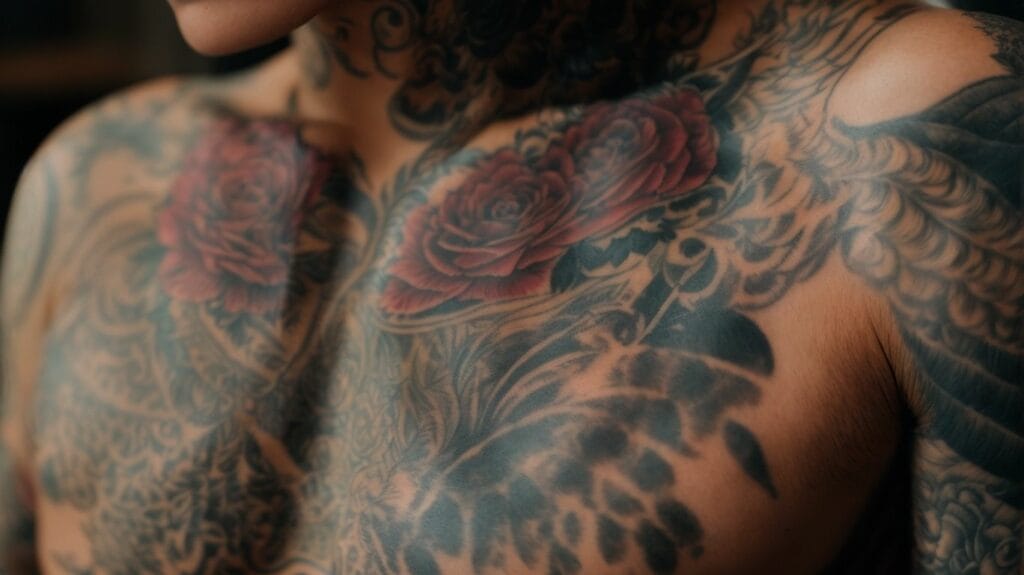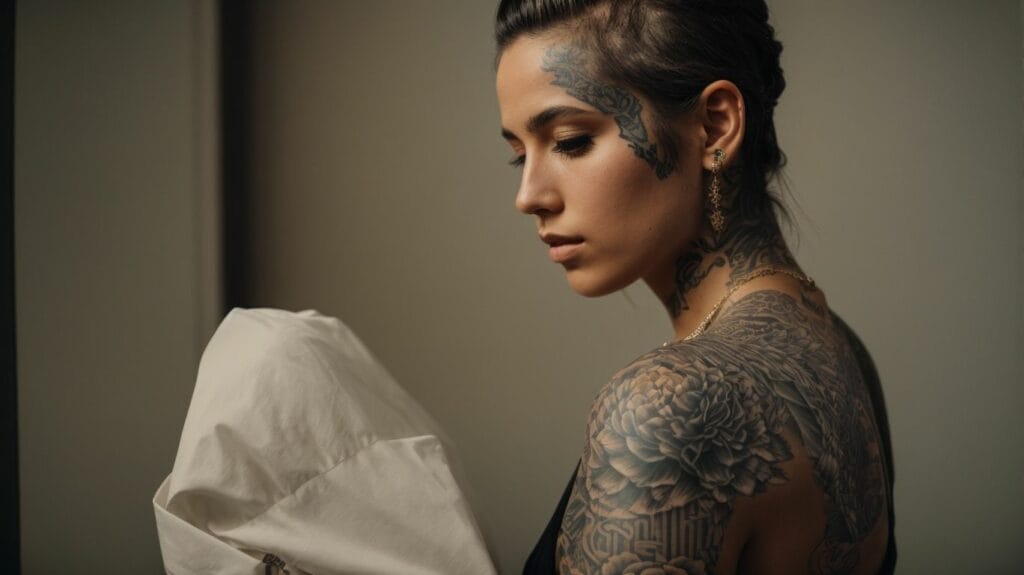Tattoos are a form of self-expression and body art that have gained popularity over the years. One common concern among individuals considering getting a tattoo is the level of pain they may experience during the process. When it comes to getting tattoos on the chest, several factors come into play that can influence the level of discomfort. Understanding these factors can help you better prepare and manage any potential pain.
Factors Affecting Tattoo Pain:
1. Location: The specific area of the chest where the tattoo is placed can affect pain levels. Some areas, like directly over the breastbone or collarbone, may be more sensitive than others.
2. Skin Sensitivity: Everyone’s skin is different, and some individuals may naturally have more sensitive skin, making the tattooing process more uncomfortable.
3. Size and Complexity of the Tattoo: Larger and more intricate designs require more time and repetitive needle insertions, leading to increased discomfort.
4. Personal Pain Tolerance: Pain tolerance varies from person to person. What may be unbearable for one individual may be bearable for another.
Does Getting a Tattoo on the Chest Hurt?
Getting a tattoo on the chest can be a moderately painful experience due to the relatively thin skin in that area and its proximity to bone. However, pain levels are subjective and can vary greatly from person to person. Some individuals may find the pain tolerable, while others may experience more discomfort.
What to Expect During a Chest Tattoo Session?
During a chest tattoo session, there are specific steps and considerations that both the tattoo artist and the client should be aware of to ensure a smoother experience.
1. Preparing the Chest Area: The tattoo artist will clean and prepare the chest area by shaving hair and disinfecting the skin beforehand.
2. Numbing Options: Depending on personal preferences and the tattoo artist’s policies, numbing creams or sprays may help minimize pain or discomfort.
3. Tattooing Process: The tattoo artist will use a tattoo machine to inject ink into the skin, following the design and outline agreed upon with the client. The pain experienced can range from a sensation of scratching to a more intense stinging feeling.
4. Aftercare Tips: Once the tattoo is completed, the artist will provide instructions, including cleaning and moisturizing the tattooed area to promote proper healing and minimize potential discomfort.
Tips to Manage Tattoo Pain on the Chest:
While getting a tattoo on the chest may involve some degree of discomfort, there are several steps you can take to manage and minimize pain:
1. Choose an Experienced Tattoo Artist: Opting for a skilled and experienced tattoo artist can ensure a smoother and less painful experience.
2. Practice Deep Breathing and Relaxation Techniques: Deep breathing exercises and relaxation techniques can help you stay calm and manage pain during the tattooing process.
3. Take Breaks if Needed: Don’t be afraid to ask for short breaks during the tattoo session, especially if the pain becomes overwhelming.
4. Use Topical Anesthetics: In consultation with your tattoo artist, consider using topical anesthetics specifically designed for tattoo pain relief to help numb the area temporarily.
By understanding the factors influencing tattoo pain, knowing what to expect during a chest tattoo session, and implementing strategies to manage discomfort, you can approach the tattooing experience with greater confidence and ease.
Key takeaways:
- Location matters: The chest is generally considered a more painful area for getting a tattoo due to the proximity to bones and thin skin.
- Pain tolerance varies: Size, complexity, and individual pain tolerance all impact the level of pain experienced during a chest tattoo session.
- Managing the pain: Choosing an experienced artist, using numbing options, practicing deep breathing, and utilizing topical anesthetics are helpful strategies for managing pain during a chest tattoo.
Factors Affecting Tattoo Pain
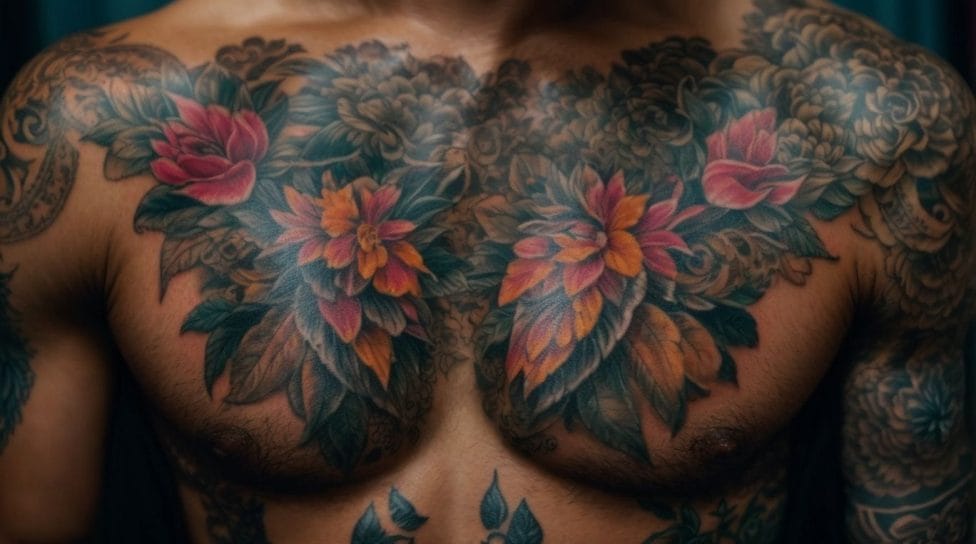
Photo Credits: Tattooineplanet.Com by Thomas Adams
When it comes to getting tattoos on your chest, several factors can influence the level of pain you might experience. From the location of your chest to your personal pain tolerance, these factors can make a significant difference. In this section, we’ll dive into what makes tattoos on the chest painful, covering aspects like skin sensitivity, the size and complexity of the tattoo, and how your pain tolerance plays a role. So fasten your seat belts and get ready to explore the fascinating world of tattoo pain!
Location
The placement of a tattoo on the body has a significant impact on the level of pain one may experience throughout the process. Different areas, such as the chest, can be more sensitive due to the delicate nature of the skin and its proximity to bones. The ability to handle pain varies from person to person. Therefore, it is vital to select a skilled tattoo artist who is adept at working on sensitive areas and can offer appropriate guidance on post-tattoo care. To manage the discomfort during the tattooing session, it can be helpful to practice deep breathing techniques, take breaks when necessary, and use topical anesthetics. Ultimately, the pain felt during a chest tattoo can vary depending on individual factors and the sensitivity of the chosen location.
The placement of a tattoo on the body has a significant impact on the level of pain one may experience throughout the process. Different areas, such as the chest, can be more sensitive due to the delicate nature of the skin and its proximity to bones. The ability to handle pain varies from person to person. Therefore, it is vital to select a skilled tattoo artist who is adept at working on sensitive areas and can offer appropriate guidance on post-tattoo care. To manage the discomfort during the tattooing session, it can be helpful to practice deep breathing techniques, take breaks when necessary, and use topical anesthetics. Ultimately, the pain felt during a chest tattoo can vary depending on individual factors and the sensitivity of the chosen location.
Skin Sensitivity
Tattoo pain in the chest can be influenced by skin sensitivity. Factors like thin skin, nerve endings, and bony areas increase sensitivity in this location. Understanding the impact of skin sensitivity is crucial for managing pain during the tattooing process.
| Chest skin is thinner than other body areas, making it more susceptible to tattoo needle sensations. |
|---|
| The chest has a high concentration of nerve endings, making it more pain-sensitive. |
| Bony areas on the chest, such as the sternum and collarbone, can cause additional discomfort during tattooing. |
Tell you a true story about Sarah, who has highly sensitive skin and decided to get a tattoo on her chest. Due to her skin sensitivity, she opted for a small design and openly discussed her concerns with an experienced tattoo artist. The artist provided extra care to minimize potential discomfort, and Sarah used numbing options to manage pain effectively. Despite experiencing discomfort, Sarah felt happy with her tattoo and appreciated the precautions she took to address her skin sensitivity.
Size and Complexity of the Tattoo
The size and complexity of a tattoo can have a significant impact on the level of pain one may experience during the tattooing process on the chest.
- Regarding size, larger tattoos generally require more time to complete, which means longer exposure to the tattoo needle. This prolonged exposure can potentially increase discomfort.
- The complexity of a tattoo also plays a role in the amount of pain felt. Intricate designs with fine detail or shading may necessitate the artist repeatedly going over the same area, resulting in additional discomfort.
To alleviate pain during a chest tattoo session, it is advisable to consider the following suggestions:
- If needed, take breaks during the process to allow your body to relax and recover.
- Consider using numbing options like topical anesthetics to reduce the sensation in the tattooed area.
- Choose an experienced tattoo artist who can work efficiently and help minimize pain.
- Practice deep breathing and relaxation techniques to manage any discomfort better.
By considering the size and complexity of the tattoo and implementing these suggestions, you can better prepare yourself for a chest tattoo session and potentially reduce the discomfort experienced.
Personal Pain Tolerance
Your personal pain tolerance plays a crucial role in determining the level of pain you will experience when getting a tattoo on your chest. Individuals have unique thresholds for pain, meaning what is bearable for one person may be excruciating for another. Therefore, it is essential to take into account your personal pain tolerance before committing to a chest tattoo. If you have a low pain tolerance, it might be wise to choose smaller and simpler designs. Consulting with a skilled tattoo artist about your concerns can provide valuable insights into the potential discomfort and assist you in finding strategies to manage it effectively throughout the tattooing process.
Does Getting a Tattoo on the Chest Hurt?
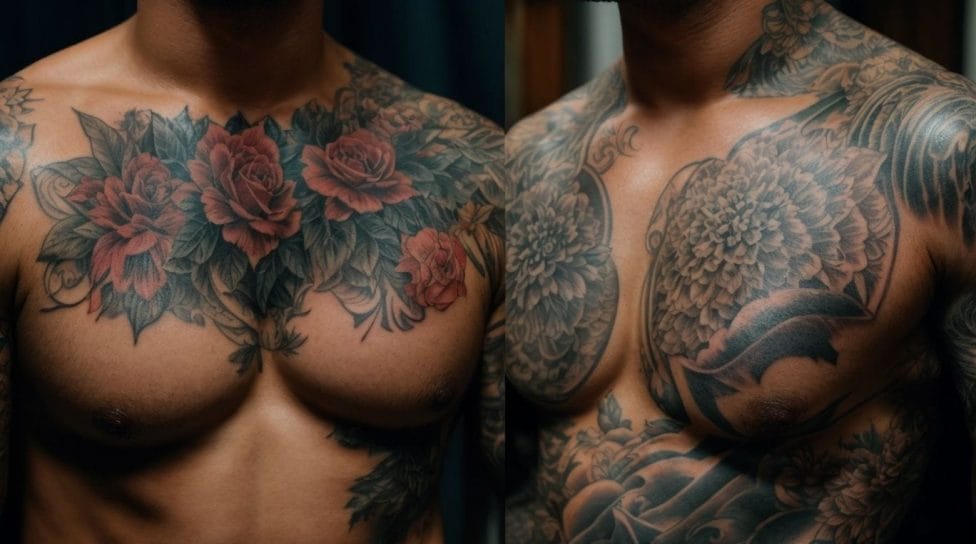
Photo Credits: Tattooineplanet.Com by Donald Rivera
Does getting a tattoo on the chest hurt?
Getting a tattoo on the chest can be a painful experience for some individuals. The chest area, known for having thinner skin and being close to the bone, can make the process more uncomfortable. Pain levels can vary from person to person, and individual pain tolerance and the size of the tattoo can also influence the level of discomfort. It’s important to communicate with your tattoo artist about any concerns you may have and to follow proper aftercare instructions to minimize discomfort and promote healing.
What to Expect During a Chest Tattoo Session?

Photo Credits: Tattooineplanet.Com by Thomas King
When getting a tattoo on your chest, it’s natural to wonder what to expect during the session. From preparing the chest area to exploring numbing options, diving into the tattooing process, and learning essential aftercare tips, this section has you covered. We’ll provide insights and valuable information so you can feel confidently informed as you embark on your chest tattoo journey. So, let’s uncover the details of what lies ahead during your chest tattoo session!
Preparing the Chest Area
Preparing the chest area before getting a tattoo is paramount for a successful and comfortable experience. Follow these steps to ensure proper preparation:
- Thoroughly cleanse the skin: Before the tattoo session, it is vital to properly clean the chest area to eliminate any dirt or oils.
- Shave the area: If you have hair on your chest, shaving the area will aid the tattoo artist in working more efficiently and will also minimize discomfort during the process.
- Keep yourself hydrated: Before your tattoo appointment, make sure to drink an ample amount of water. This will help keep your skin hydrated, resulting in a smoother process.
- Avoid alcohol and blood-thinning medications: To prevent excessive bleeding and potential complications, it is advised to abstain from consuming alcohol and medications such as aspirin before getting tattooed.
- Opt for comfortable clothing: It is recommended to wear loose-fitting and breathable clothing that allows easy access to the chest area. This ensures both comfort and convenience during the tattoo session.
Numbing Options
There are a variety of numbing options available to manage the pain during a chest tattoo session effectively.
- Topical numbing creams: These can be applied to the skin before the tattooing process to minimize pain and discomfort.
- Anesthetic sprays: Certain tattoo artists may use anesthetic sprays that temporarily numb the skin.
- Numbing injections: In certain situations, a local anesthetic may be injected into the chest area to numb the pain during the tattooing process.
- Pain relievers: Before the tattoo session, taking over-the-counter pain relievers such as ibuprofen or acetaminophen can help alleviate pain somewhat.
It’s crucial to consult with either your tattoo artist or a healthcare professional to determine the most appropriate numbing option for your specific situation.
Tattooing Process
- The tattooing process is a series of crucial steps for achieving a successful and satisfying result.
- During the design consultation, you will have the opportunity to discuss your tattoo idea with the artist and collaborate on creating a personalized design.
- After the design is finalized, the artist will proceed with stencil placement, where they will create a stencil of the design and carefully transfer it onto your chest.
- Pain management is an important consideration in the tattooing process. It is advised to prepare yourself mentally and, if necessary, explore numbing options to ensure a more comfortable experience.
- Tattooing is the main stage of the process, where the artist utilizes sterilized equipment to etch the design onto your chest precisely.
- After the initial tattooing, the artist may need to perform touch-ups to perfect and enhance the overall design.
- Proper aftercare is essential for the healing and maintaining your new chest tattoo. It is crucial to follow the artist’s instructions to ensure optimal healing and long-lasting results.
Fact: The tattooing process is a unique and meaningful journey that allows individuals to express themselves through art on their bodies.
Aftercare Tips
Proper aftercare is crucial for a successful tattoo healing process on the chest. Here are some essential tips to follow:
- Clean the area: Gently wash the tattooed area with mild soap and warm water to prevent infection.
- Moisturize regularly: Apply a thin layer of tattoo aftercare lotion to keep the skin hydrated and promote healing.
- Avoid picking or scratching: Resist the urge to scratch or pick at the tattoo, which can lead to scarring or ink loss.
- Avoid exposure to direct sunlight: Protect your tattoo from the sun by wearing clothing or applying sunblock to prevent fading.
- Avoid swimming or excessive sweating: Refrain from swimming or intense physical activity until the tattoo is fully healed to prevent infections.
Tips to Manage Tattoo Pain on the Chest
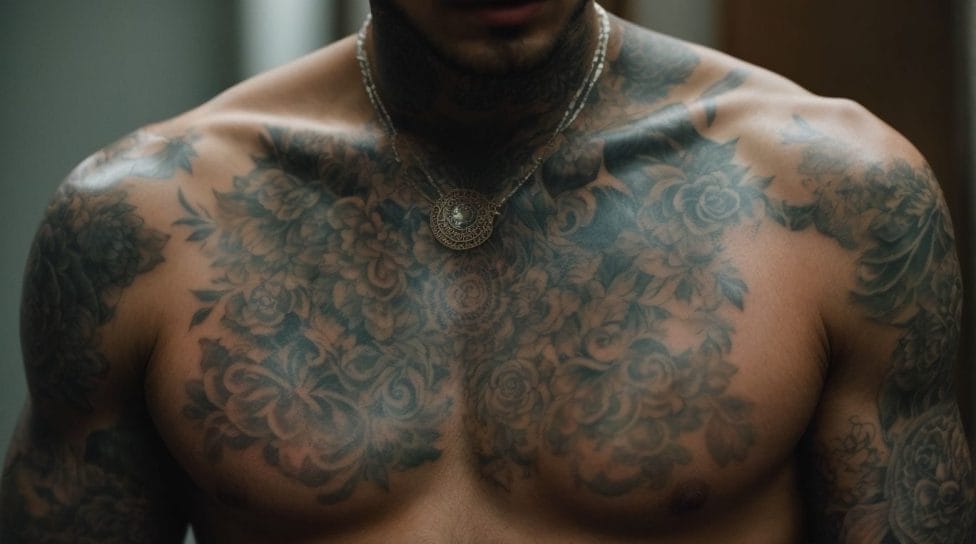
Photo Credits: Tattooineplanet.Com by Frank White
Are you looking to get a chest tattoo but worried about the pain? Don’t fret! In this section, we’ve covered you with some valuable tips to manage tattoo pain on your chest. From selecting an experienced tattoo artist to practicing deep breathing and relaxation techniques, we’ll discuss various strategies that can help ease the discomfort. So, if you’re ready to embark on your chest tattoo journey, read on to discover the secrets of minimizing tattoo pain and maximizing your tattoo experience.
Choose an Experienced Tattoo Artist
When looking to get a tattoo on your chest, it is of utmost importance to carefully select an artist with a wealth of experience in the field. This decision guarantees that the chosen tattoo artist possesses the essential abilities and expertise to produce an exceptional tattoo while minimizing the likelihood of encountering any potential risks or complications. A proficient tattoo artist will readily present you with a comprehensive portfolio showcasing their unique style and skill level. Furthermore, their establishment will adhere to rigorous standards of cleanliness and sterility, thereby ensuring the utmost hygiene practices. By deliberately choosing to work with an experienced tattoo artist, you can confidently trust that your tattoo will be executed with the highest safety and professionalism.
Practice Deep Breathing and Relaxation Techniques
Practice deep breathing and relaxation techniques to manage the pain during a chest tattoo session effectively. Here are a few simple steps you can follow for a more comfortable experience:
- Ensure you find a comfortable position, either sitting or lying down.
- Close your eyes and take a deep breath through your nose, allowing the air to fill your lungs.
- Hold your breath for a few seconds, and then slowly exhale through your mouth, releasing any tension or discomfort.
- Repeat this deep breathing pattern multiple times, focusing on each breath to relax your body further.
- In addition to deep breathing, try muscle relaxation techniques by consciously tensing and releasing different muscle groups.
- To distract yourself from any discomfort, visualize a peaceful scene or engage in positive self-talk.
- Remember to communicate openly with your tattoo artist about any discomfort or breaks you may need.
Fact: The practice of deep breathing and relaxation techniques can effectively reduce pain by triggering the release of endorphins, which act as the body’s natural painkillers.
Take Breaks if Needed
- During a chest tattoo session, it is important to take breaks if needed to help manage the pain and discomfort.
- One of the steps to follow is to communicate with your tattoo artist and let them know if you need a break. They will understand and accommodate your needs.
- To ensure a more comfortable tattoo experience, it is recommended to set a schedule and plan breaks in advance. This will give you something to look forward to and mentally prepare.
- Mind-over-matter techniques like deep breathing can help calm your nerves and distract you from the pain during breaks.
- Staying hydrated by drinking plenty of water during breaks can help refresh your body and mind.
- To relieve muscle tension, it is beneficial to take short walks or do gentle stretches during breaks.
Remember, listening to your body and taking breaks when needed is crucial for a comfortable tattoo experience.
Use Topical Anesthetics
Using topical anesthetics can help manage pain during a chest tattoo session. Here are some steps to follow:
- Ensure proper pain management by using topical anesthetics.
- Before applying the anesthetic cream or gel, thoroughly clean the chest area.
- Follow the instructions provided with the anesthetic cream or gel carefully.
- To ensure full coverage, apply a thin layer of the topical anesthetic on the tattoo area.
- Enhance the anesthetic absorption by covering the tattooed area with a plastic wrap or occlusive dressing.
- For the recommended duration, typically around 45 minutes to an hour, leave the anesthetic on.
- Before starting the tattooing process, remove the plastic wrap carefully and wipe away any excess anesthetic.
- During the session, communicate any discomfort or pain experienced to your tattoo artist.
- For proper healing, follow the aftercare instructions provided by your tattoo artist.
Historically, the use of topical anesthetics during tattoo sessions has been a common practice to help minimize pain and discomfort. The advancements in tattoo technology and pain management techniques have made the experience more tolerable for individuals seeking chest tattoos.
Some Facts About Whether Tattoos on the Chest Hurt:
- ✅ Chest tattoos can be painful, especially in the collarbone area. (Source: Our Team)
- ✅ The chest has more nerve endings and closer bones, which can make tattooing more painful. (Source: Our Team)
- ✅ Pain tolerance varies among individuals, so the pain level experienced during a chest tattoo can differ. (Source: Our Team)
- ✅ Having more body fat or muscle in the chest area can cushion and help with pain during tattooing. (Source: Our Team)
- ✅ Experienced tattoo artists can help manage pain during chest tattoos, using techniques such as distraction and adjusting the tattooing speed. (Source: Our Team)
